Citroen C5 2017 (RD/TD) / 2.G Owner's Manual
Manufacturer: CITROEN, Model Year: 2017, Model line: C5, Model: Citroen C5 2017 (RD/TD) / 2.GPages: 348, PDF Size: 10.72 MB
Page 111 of 348
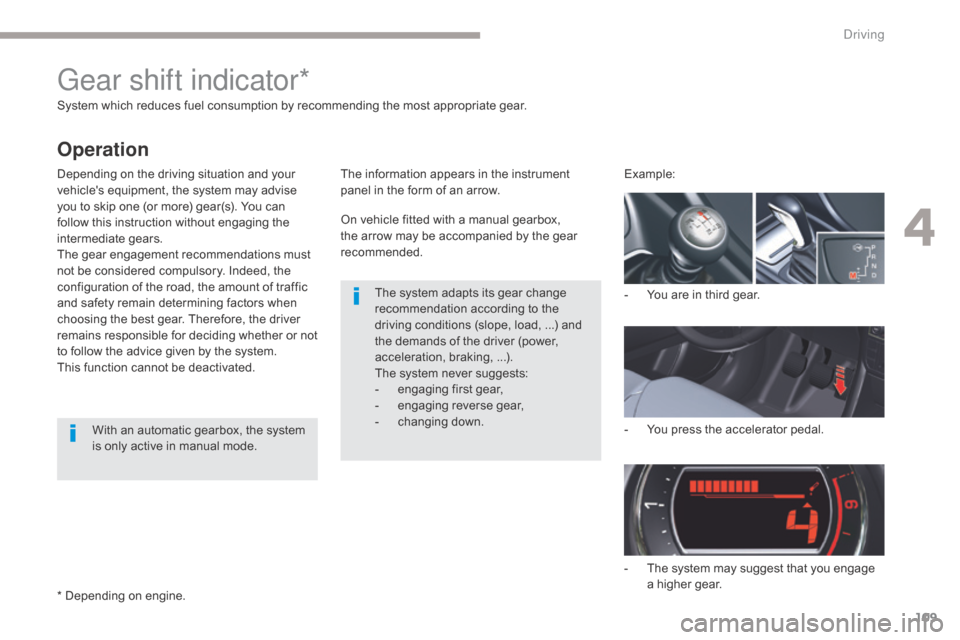
109
C5_en_Chap04_conduite_ed01-2016
System which reduces fuel consumption by recommending the most appropriate gear.
Depending on the driving situation and your
vehicle's equipment, the system may advise
you to skip one (or more) gear(s). You can
follow this instruction without engaging the
intermediate gears.
The gear engagement recommendations must
not be considered compulsory. Indeed, the
configuration of the road, the amount of traffic
and safety remain determining factors when
choosing the best gear. Therefore, the driver
remains responsible for deciding whether or not
to follow the advice given by the system.
This function cannot be deactivated.Example:
-
Y
ou are in third gear.
-
Y
ou press the accelerator pedal.
Gear shift indicator*
Operation
With an automatic gearbox, the system
is only active in manual mode.
* Depending on engine. The information appears in the instrument
panel in the form of an arrow.
On vehicle fitted with a manual gearbox,
the arrow may be accompanied by the gear
recommended.
The system adapts its gear change
recommendation according to the
driving conditions (slope, load, ...) and
the demands of the driver (power,
acceleration, braking, ...).
The system never suggests:
-
e
ngaging first gear,
-
enga
ging reverse gear,
- c hanging down.
-
T
he system may suggest that you engage
a higher gear.
4
Driving
Page 112 of 348
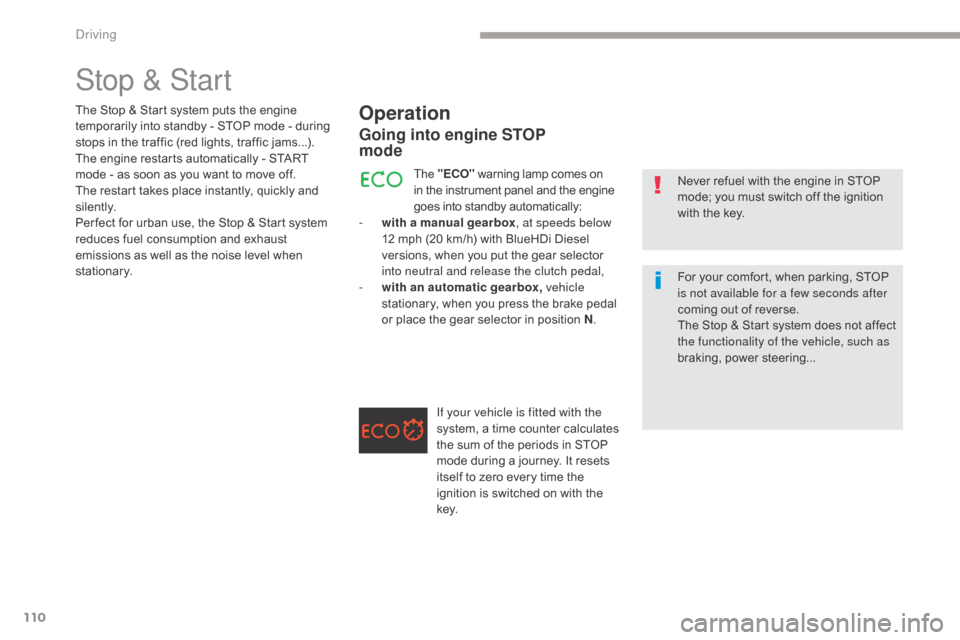
110
C5_en_Chap04_conduite_ed01-2016
Stop & Start
Operation
- with a manual gearbox, at speeds below
12 mph (20 km/h) with BlueHDi Diesel
versions, when you put the gear selector
into neutral and release the clutch pedal,
-
w
ith an automatic gearbox, vehicle
stationary, when you press the brake pedal
or place the gear selector in position N .
Going into engine STOP
mode
The "ECO" warning lamp comes on
in the instrument panel and the engine
goes into standby automatically:
If your vehicle is fitted with the
system, a time counter calculates
the sum of the periods in STOP
mode during a journey. It resets
itself to zero every time the
ignition is switched on with the
key.
The Stop & Start system puts the engine
temporarily into standby - STOP mode - during
stops in the traffic (red lights, traffic jams...).
The engine restarts automatically - START
mode - as soon as you want to move off.
The restart takes place instantly, quickly and
silently.
Per fect for urban use, the Stop & Start system
reduces fuel consumption and exhaust
emissions as well as the noise level when
stationary.
Never refuel with the engine in STOP
mode; you must switch off the ignition
with the key.
For your comfort, when parking, STOP
is not available for a few seconds after
coming out of reverse.
The Stop & Start system does not affect
the functionality of the vehicle, such as
braking, power steering...
Driving
Page 113 of 348
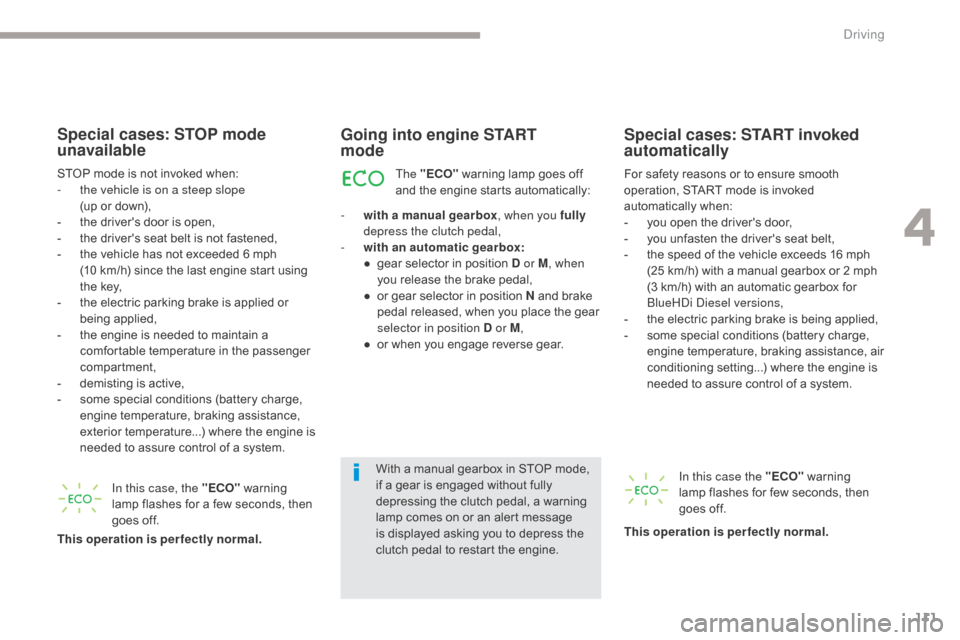
111
C5_en_Chap04_conduite_ed01-2016
- with a manual gearbox, when you fully
depress the clutch pedal,
-
w
ith an automatic gearbox:
●
g
ear selector in position D or M , when
you release the brake pedal,
●
o
r gear selector in position N and brake
pedal released, when you place the gear
selector in position D or M ,
●
o
r when you engage reverse gear.
Going into engine START
mode
The "ECO" warning lamp goes off
and the engine starts automatically:
Special cases: START invoked
automatically
In this case the "ECO" warning
lamp flashes for few seconds, then
goes off.
This operation is perfectly normal. For safety reasons or to ensure smooth
operation, START mode is invoked
automatically when:
-
y
ou open the driver's door,
-
y
ou unfasten the driver's seat belt,
-
t
he speed of the vehicle exceeds 16 mph
(25 km/h) with a manual gearbox or 2 mph
(3 km/h) with an automatic gearbox for
BlueHDi Diesel versions,
-
t
he electric parking brake is being applied,
-
s
ome special conditions (battery charge,
engine temperature, braking assistance, air
conditioning setting...) where the engine is
needed to assure control of a system.
Special cases: STOP mode
unavailable
In this case, the "ECO" warning
lamp flashes for a few seconds, then
goes off.
This operation is perfectly normal. STOP mode is not invoked when:
-
t
he vehicle is on a steep slope
(up or down),
-
t
he driver's door is open,
-
t
he driver's seat belt is not fastened,
-
t
he vehicle has not exceeded 6 mph
(10 km/h) since the last engine start using
the key,
-
t
he electric parking brake is applied or
being applied,
-
t
he engine is needed to maintain a
comfortable temperature in the passenger
compartment,
-
d
emisting is active,
-
s
ome special conditions (battery charge,
engine temperature, braking assistance,
exterior temperature...) where the engine is
needed to assure control of a system.
With a manual gearbox in STOP mode,
if a gear is engaged without fully
depressing the clutch pedal, a warning
lamp comes on or an alert message
is displayed asking you to depress the
clutch pedal to restart the engine.
4
Driving
Page 114 of 348
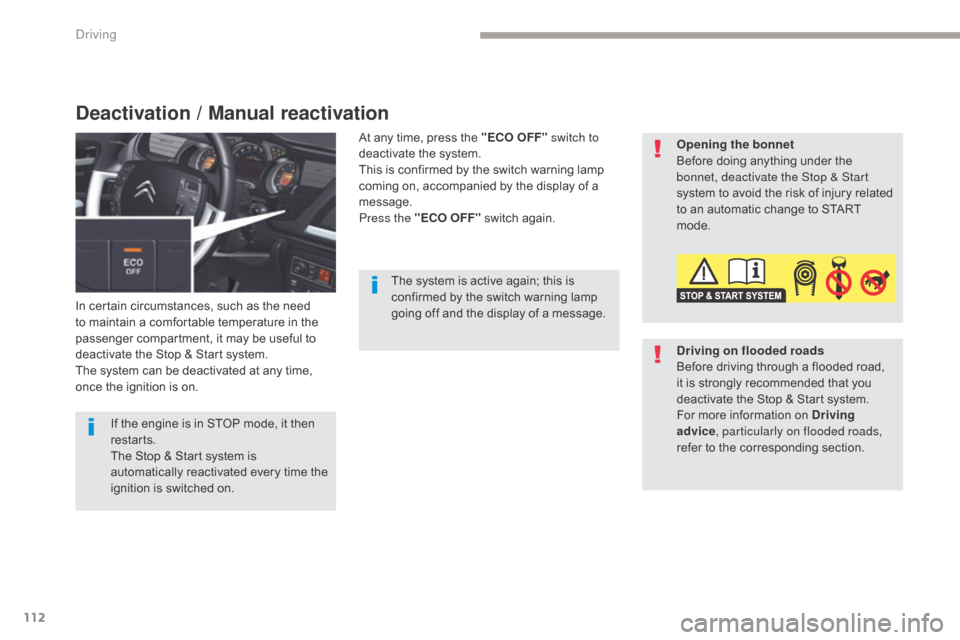
112
C5_en_Chap04_conduite_ed01-2016
Opening the bonnet
Before doing anything under the
bonnet, deactivate the Stop & Start
system to avoid the risk of injury related
to an automatic change to START
mode.
Driving on flooded roads
Before driving through a flooded road,
it is strongly recommended that you
deactivate the Stop & Start system.
For more information on Driving
advice, particularly on flooded roads,
refer to the corresponding section.
At any time, press the "ECO OFF"
switch to
deactivate the system.
This is confirmed by the switch warning lamp
coming on, accompanied by the display of a
message.
Press the "ECO OFF" switch again.
The system is active again; this is
confirmed by the switch warning lamp
going off and the display of a message.
In certain circumstances, such as the need
to maintain a comfortable temperature in the
passenger compartment, it may be useful to
deactivate the Stop & Start system.
The system can be deactivated at any time,
once the ignition is on.
Deactivation / Manual reactivation
If the engine is in STOP mode, it then
restarts.
The Stop & Start system is
automatically reactivated every time the
ignition is switched on.
Driving
Page 115 of 348
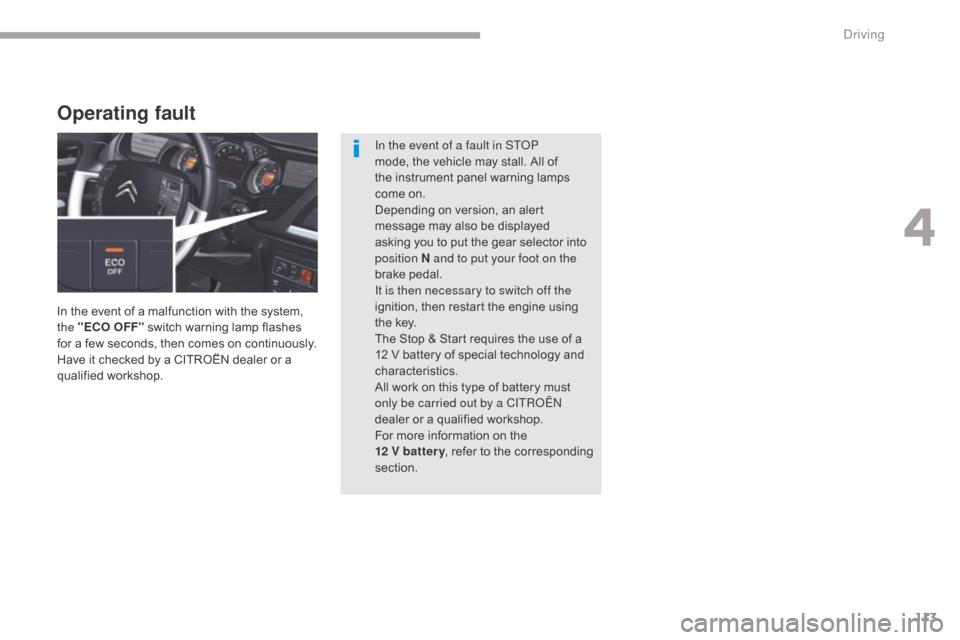
113
C5_en_Chap04_conduite_ed01-2016
Operating fault
In the event of a malfunction with the system,
the "ECO OFF" switch warning lamp flashes
for a few seconds, then comes on continuously.
Have it checked by a CITROËN dealer or a
qualified workshop.In the event of a fault in STOP
mode, the vehicle may stall. All of
the instrument panel warning lamps
come
on.
Depending on version, an alert
message may also be displayed
asking you to put the gear selector into
position
N and to put your foot on the
brake pedal.
It is then necessary to switch off the
ignition, then restart the engine using
the key.
The Stop & Start requires the use of a
12 V battery of special technology and
characteristics.
All work on this type of battery must
only be carried out by a CITROËN
dealer or a qualified workshop.
For more information on the
12
V batter y, refer to the corresponding
section.
4
Driving
Page 116 of 348
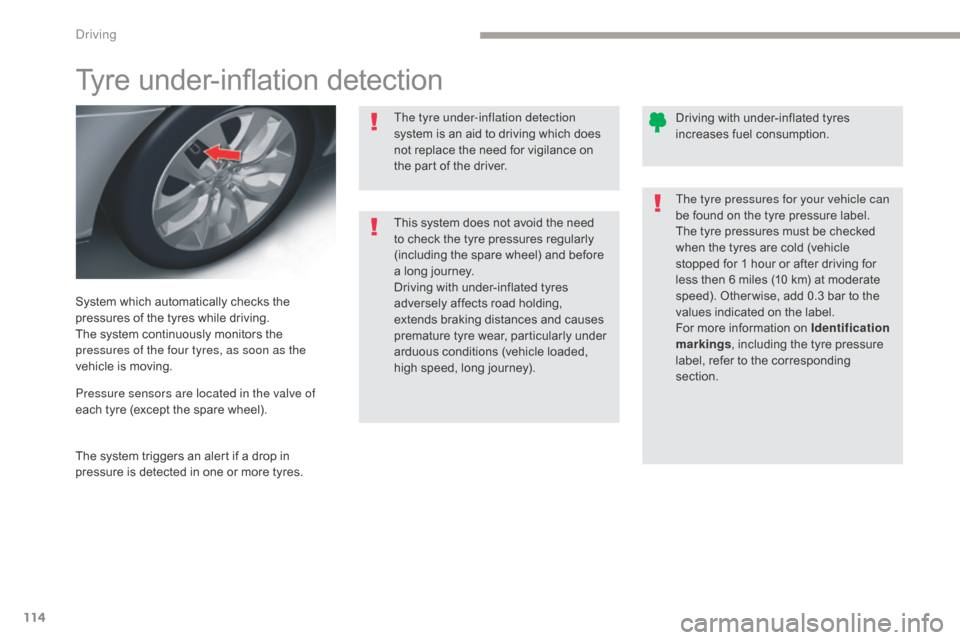
114
C5_en_Chap04_conduite_ed01-2016
Tyre under-inflation detection
System which automatically checks the
pressures of the tyres while driving.
The system continuously monitors the
pressures of the four tyres, as soon as the
vehicle is moving.The tyre under-inflation detection
system is an aid to driving which does
not replace the need for vigilance on
the part of the driver.
This system does not avoid the need
to check the tyre pressures regularly
(including the spare wheel) and before
a long journey.
Driving with under-inflated tyres
adversely affects road holding,
extends braking distances and causes
premature tyre wear, particularly under
arduous conditions (vehicle loaded,
high speed, long journey).
The tyre pressures for your vehicle can
be found on the tyre pressure label.
The tyre pressures must be checked
when the tyres are cold (vehicle
stopped for 1 hour or after driving for
less then 6 miles (10 km) at moderate
speed). Other wise, add 0.3 bar to the
values indicated on the label.
For more information on Identification
markings
, including the tyre pressure
label, refer to the corresponding
section. Driving with under-inflated tyres
increases fuel consumption.
Pressure sensors are located in the valve of
each tyre (except the spare wheel).
The system triggers an alert if a drop in
pressure is detected in one or more tyres.
Driving
Page 117 of 348
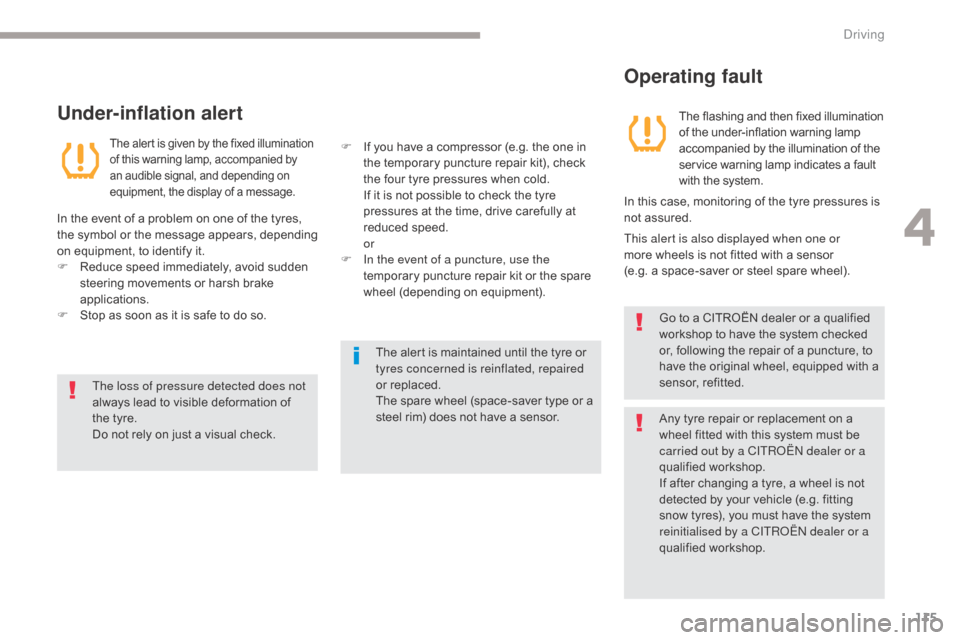
115
C5_en_Chap04_conduite_ed01-2016
The loss of pressure detected does not
always lead to visible deformation of
the tyre.
Do not rely on just a visual check.The alert is maintained until the tyre or
tyres concerned is reinflated, repaired
or replaced.
The spare wheel (space-saver type or a
steel rim) does not have a sensor.
Under-inflation alert
The alert is given by the fixed illumination
of this warning lamp, accompanied by
an audible signal, and depending on
equipment, the display of a message.
In the event of a problem on one of the tyres,
the symbol or the message appears, depending
on equipment, to identify it.
F
R
educe speed immediately, avoid sudden
steering movements or harsh brake
applications.
F
S
top as soon as it is safe to do so. F
I
f you have a compressor (e.g. the one in
the temporary puncture repair kit), check
the four tyre pressures when cold.
I
f it is not possible to check the tyre
pressures at the time, drive carefully at
reduced speed.
or
F
I
n the event of a puncture, use the
temporary puncture repair kit or the spare
wheel (depending on equipment).
Operating fault
The flashing and then fixed illumination
of the under-inflation warning lamp
accompanied by the illumination of the
service warning lamp indicates a fault
with the system.
This alert is also displayed when one or
more
wheels is not fitted with a sensor
(e.g. a space-saver or steel spare wheel).
Go to a CITROËN dealer or a qualified
workshop
to have the system checked
or, following the repair of a puncture, to
have the original wheel, equipped with a
sensor, refitted.
Any tyre repair or replacement on a
wheel fitted with this system must be
carried out by a CITROËN dealer or a
qualified workshop.
If after changing a tyre, a wheel is not
detected by your vehicle (e.g. fitting
snow tyres), you must have the system
reinitialised by a CITROËN dealer or a
qualified workshop.
In this case, monitoring of the tyre pressures is
not assured.
4
Driving
Page 118 of 348
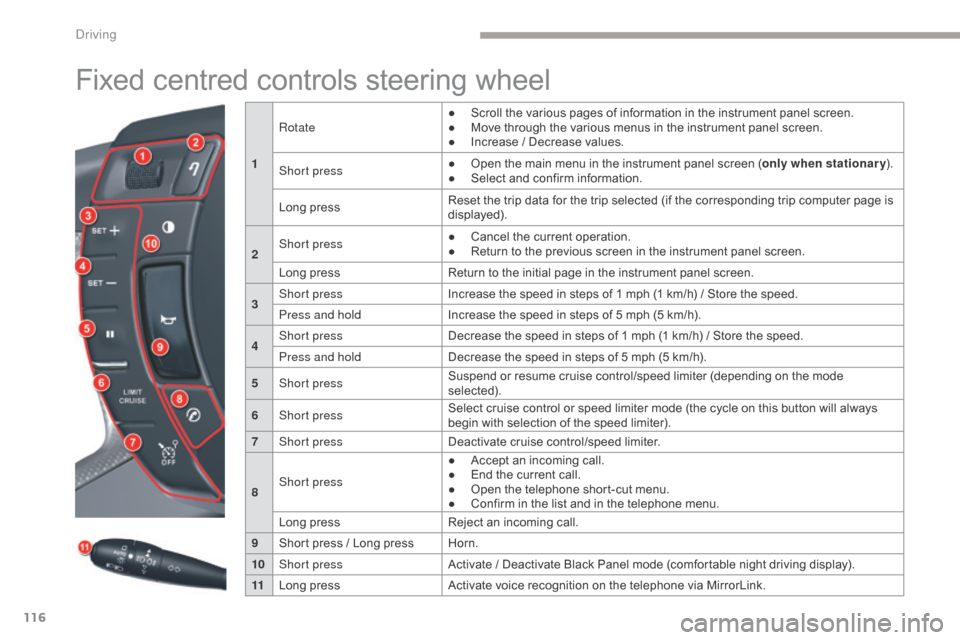
116
C5_en_Chap04_conduite_ed01-2016
Fixed centred controls steering wheel
1Rotate
●
S
croll the various pages of information in the instrument panel screen.
●
M
ove through the various menus in the instrument panel screen.
●
I
ncrease / Decrease values.
Short press ●
O pen the main menu in the instrument panel screen (
only when stationary).
● S elect and confirm information.
Long press Reset the trip data for the trip selected (if the corresponding trip computer page is
displayed).
2 Short press
●
C
ancel the current operation.
●
R
eturn to the previous screen in the instrument panel screen.
Long press Return to the initial page in the instrument panel screen.
3 Short press
Increase the speed in steps of 1 mph (1 km/h) / Store the speed.
Press and hold Increase the speed in steps of 5 mph (5 km/h).
4 Short press
Decrease the speed in steps of 1 mph (1 km/h) / Store the speed.
Press and hold Decrease the speed in steps of 5 mph (5 km/h).
5 Short press Suspend or resume cruise control/speed limiter (depending on the mode
selected).
6 Short press Select cruise control or speed limiter mode (the cycle on this button will always
begin with selection of the speed limiter).
7 Short press Deactivate cruise control/speed limiter.
8 Short press ●
A
ccept an incoming call.
●
E
nd the current call.
●
O
pen the telephone short-cut menu.
●
C
onfirm in the list and in the telephone menu.
Long press Reject an incoming call.
9 Short press / Long press Horn.
10 Short press Activate / Deactivate Black Panel mode (comfortable night driving display).
11 Long press Activate voice recognition on the telephone via MirrorLink.
Driving
Page 119 of 348
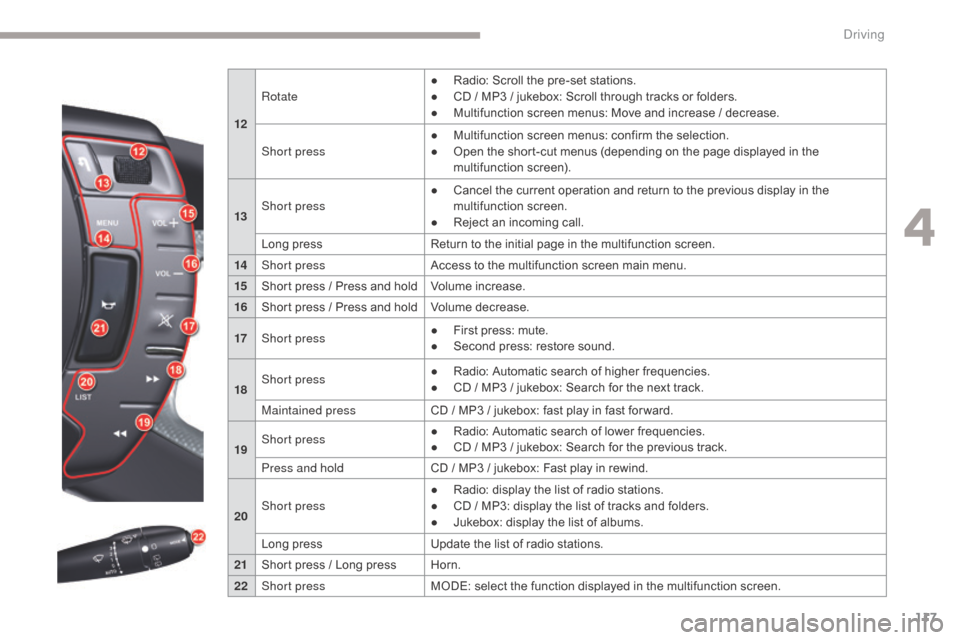
117
C5_en_Chap04_conduite_ed01-2016
12Rotate
●
R
adio: Scroll the pre-set stations.
●
C
D / MP3 / jukebox: Scroll through tracks or folders.
● M ultifunction screen menus: Move and increase / decrease.
Short press ●
M ultifunction screen menus: confirm the selection.
●
O
pen the short-cut menus (depending on the page displayed in the
multifunction screen).
13 Short press ●
C
ancel the current operation and return to the previous display in the
multifunction screen.
●
R
eject an incoming call.
Long press Return to the initial page in the multifunction screen.
14 Short press Access to the multifunction screen main menu.
15 Short press / Press and hold Volume increase.
16 Short press / Press and hold Volume decrease.
17 Short press ●
F
irst press: mute.
●
S
econd press: restore sound.
18 Short press
●
R
adio: Automatic search of higher frequencies.
●
C
D / MP3 / jukebox: Search for the next track.
Maintained press CD / MP3 / jukebox: fast play in fast for ward.
19 Short press
●
R
adio: Automatic search of lower frequencies.
●
C
D / MP3 / jukebox: Search for the previous track.
Press and hold CD / MP3 / jukebox: Fast play in rewind.
20 Short press ●
R
adio: display the list of radio stations.
●
C
D / MP3: display the list of tracks and folders.
●
J
ukebox: display the list of albums.
Long press Update the list of radio stations.
21 Short press / Long press Horn.
22 Short press MODE: select the function displayed in the multifunction screen.
4
Driving
Page 120 of 348

118
C5_en_Chap04_conduite_ed01-2016
Speed limiter
Steering mounted controls
The speed limiter switches are located on the
left-hand side of the steering wheel.
1.
I
ncrease the programmed speed.
2.
D
ecrease the programmed speed.
3.
S
peed limiter On / Pause.
4.
S
elect speed limiter mode.
5.
D
eactivate the speed limiter.
Displays in the instrument panel
The information related to the speed limiter is
grouped together in zone A of the instrument
panel.
System which prevents the vehicle from
exceeding the speed programmed by the
driver.
When the limit speed is reached, the
accelerator pedal no longer has any effect.
The speed limiter is switched on manually: a
speed of at least 20 mph (approx. 30 km/h)
must be programmed.
The speed limiter can in no circumstances
replace keeping to speed limits or the
need for vigilance on the part of the driver.
Driving